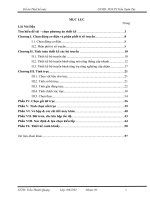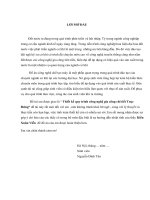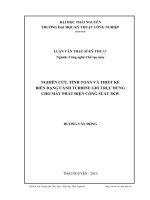Tuabin gió trục đứng
Bạn đang xem bản rút gọn của tài liệu. Xem và tải ngay bản đầy đủ của tài liệu tại đây (430.01 KB, 9 trang )
Development and Analysis of a Novel Vertical Axis Wind Turbine
Paul Cooper and Oliver Kennedy
School of Mechanical, Materials and Mechatronic Engineering
University of Wollongong, Wollongong, NSW 2522,
AUSTRALIA
E-mail:
Abstract
This paper describes the development of a novel vertical axis wind turbine used for
teaching and research purposes. The device is designed to operate at low tip speed ratios
and features blades that are symmetric about the mid-chord plane. The blades are
actively pitched by means of a mechanical system so that the chord of each blade rotates
by 180º for every revolution of the main rotor. One of the attractions of the device is that
it is self-starting and produces relatively high torque. A multiple streamtube analysis of
the device has been developed and numerical predictions for the performance of the
device are presented. Commissioning and field tests of a prototype are described and
some preliminary performance results are presented and discussed.
1.INTRODUCTION
Wind energy is rapidly emerging as one of the most cost-effective forms of renewable energy with
very significant increases in annual installed capacity being reported around the world. The
favoured form of turbines used for electricity generation purposes is the Horizontal Axis Wind
Turbine (HAWT) with low solidity ratio (ratio of blade area to swept area) and high tip speed ratio,
λ = ΩR/Vwind, where R is the radius of the blades and Vwind is the wind velocity. This type of
turbine has a high efficiency or coefficient of performance, Cp, but relatively low torque. By
contrast, the traditional “American Windmill” or “Southern Cross”, used throughout Australia and
the USA for water pumping purposes, is a high solidity, low tip speed ratio device that produces a
high torque suitable for direct drive of relatively simple mechanical pump systems. The second
major group of wind turbine types are the Vertical Axis Wind Turbines (VAWTs). A wide variety of
VAWT configurations have been proposed, dating from the Persian VAWTs used for milling grain
over a thousand years ago, through to the Darrieus turbine, invented in 1926 by Georges
Darrieus, which has been used extensively for power generation. In fact one of the largest
turbines ever built was the 96m high 64m diameter Éole Darrieus built near, Quebec, Canada,
with a rated power output of 3.8MW and a rotor weighing 100tonnes. Other VAWT configurations
include the Savonius VAWT, which is popular because of the simplicity of manufacture, and the
straight bladed VAWTs. The latter include the Musgrove turbine that was developed culminating
in successful testing of a 500kW device at Carmarthen Bay in the UK (Peace, 2004).
In Australia, Kirke (1998) reported on his extensive testing and analysis of a number of “giromill”
type VAWTs with the blade pitch controlled so as to optimise the aerodynamic angle of attack on
the blade aerofoils on both the upwind and downwind blade passes. Kirke’s work culminated in
the development and field-testing of two devices used for electricity generation. In New Zealand,
Solwind Ltd have developed and are marketing a number of VAWTs for electricity generation.
HAWTs have come to dominate the market for electricity generation for several reasons including
low cost. However, VAWTs do have several inherent advantages over HAWTs including: VAWTs
do not have to have a means of “yawing” (rotating about a vertical axis) to follow the changing
wind direction; the generator (or other power takeoff device) can be located at ground level,
reducing the structural requirements of the support tower. However, a disadvantage of most
VAWT configurations is the fact that they have either low or insignificant starting torque, so that in
the case of Darrieus devices, for example, the rotor must be brought up to speed either by using
the generator as a motor or by means of a small secondary rotor, such as a Savonius, mounted
on the Darrieus main shaft.
The present work was originally devised as a student project to examine the possibility of
developing a small scale, high torque, self-starting VAWT for applications such as water pumping.
In the following we outline the development of the concept of the novel turbine; the development
of a theoretical model of the device; and the design, manufacture, commissioning and preliminary
testing of the device
2. CONCEPTUAL DEVELOPMENT OF THE NOVEL TURBINE
The development of the “Wollongong Turbine” was initiated when a local inventor, Mr John
Boothman, approached the present authors with a concept for a wind turbine and a working
model with a swept area of approximately 0.25m2. The working model had a horizontal axis and
a rotor with three blades with their axes held parallel to the main rotor axis. The blades were
simple flat plates, the pitch of which was controlled by means of a chain and sprocket
arrangement so that the blades rotated about their own longitudinal axes by only 180º for each
full revolution of the main rotor. The motion of the blades is shown schematically in figure 1.
Subsequent to the initial approach by Boothman a literature search revealed that a similar
concept (with chain driven blade pitch control) had been mentioned by Golding (1976) but no
evidence could be found of such a device having been theoretically modelled in detail or built
Figure 1. Plan view schematic of the orientation of blades and rotor of the novel VAWT.
While at first sight this device appears to be a “drag” device where Blade 2 in figure 1a is clearly
acting effectively as a plate perpendicular to the undisturbed flow of wind, it is also clear that
liftforces on all three blades have the potential to act to generate positive torque throughout a
complete revolution of the rotor. The working model of the horizontal axis device was tested in a
wind tunnel and in the field by Riggall (1999). The results were promising given the relatively
crude construction of the model, with coefficients of performance (efficiency) measured between
0.2 and 0.3. It was therefore decided to investigate the concept further with a view to providing an
interesting research project for final year honours engineering students and a study of a
fundamental aerodynamic problem.
The original proposal for the rotor axis to be located horizontally by Boothman was clearly not
ideal for a working device since the machine would have to be made to yaw into the wind by
some means, which would be both costly and structurally difficult. Two major design innovations
were devised to bring the concept to a workable configuration. Firstly, the rotor axis was brought
to a vertical orientation with a wind vane mounted on a control shaft to orientate the blades with
changing wind direction. Secondly, Boston (2000) devised a system of bevel gears to replace the
chains on the original working model that controlled the pitching of the blades. Thus, the
configuration of the device was transformed to a VAWT with wind vane for orientation of the blade
pitch mechanism as shown in figures 2 and 3a.
3. PRACTICAL IMPLEMENTATION
A practical implementation of the device outlined above was developed as a design exercise and
as a demonstration of the concept for use in the Sustainable Energy Technology education
program in the Faculty of Engineering, University of Wollongong. The major dimensions of the
rotor/blade system were as follows: blade length, L = 2.4m; blade chord, c = 0.56m; rotor radius
(to shaft supporting the blade), R = 1.0m; number of blades, n =3. One of the original concepts
behind the configuration of the device was that the blades could be of relatively simple
construction. However, since the blades rotate a full 360º relative to the wind during the blade
profile chosen must symmetrical about the mid-chord plane. Although this meant that a flat plate
could be used it was decided that for structural and aerodynamic reasons to use a more
aerodynamically appropriate blade profile. The three blades were made from a skin of 0.8mm
aluminium sheet formed over spars mounted a hollow aluminium bar running through the centre
of the blade. The blade profile, shown in Figure 3b, was essentially the upstream half of a NACA
0010 – 65 section reflected about the mid-chord.
Figure 2. Schematic of
wind turbine design.
Figure 3. a) Plan view of the pitch control mechanism mounted
on the upper support arms. b) Cross section through a blade.
The blades were suspended between the upper and lower support arms, which, in turn were
mounted on a 139mm OD “main shaft” with two concentric inner shafts. The wind vane was
mounted on the innermost “wind direction” shaft. This was mechanically locked with the
“intermediate shaft” on which was mounted the “control bevel gear” to activate the blade pitch
mechanism. The relative orientation of the wind direction and intermediate shafts design that they
could be adjusted through 90º to bring the blades into a “furled” position so as to provide a means
of reducing the torque output of the rotor to zero as shown in Figure 4.
The entire rotor system was mounted on a substantial 3m high steel lattice tower which could be
tilted by means of hydraulic rams to allow easy access to the rotor assembly and so that the
turbine could be lowered when not undergoing field tests. For reasons of security the
arrangement was located on top of a multi-storey car park approximately 10m high. The torque
from the main rotor shaft was taken via a two-stage 14:1 belt drive to a specially built three-
phase, 240v, permanent magnet ac generator. A purpose-built control system was connected
between the generator and a resistive load whereby the control system could be set to maintain
an approximately constant rotational speed of the turbine with varying wind speed. The ac output
from the generator was converted to dc, which was then fed to the resistive load via pulse width
modulation of thyristors. Mechanical power output from the rotor was measured by mounting the
generator on trunnion bearings so that the torque transmitted to the generator shaft could be
measured by means of a torque arm and load cell. Angular velocity of the shaft was measured by
means of an encoder. A DataTaker 50 data acquisition system was used to monitor the following
parameters: the torque and rpm of the generator; the orientation of the turbine wind vane; and the
wind speed/direction and air temperature from a weather station located approximately 5m from
the turbine. The sample rate for these measurements was 1Hz, however, higher speed data
acquisition utilizing a Sony PC 208AX Dat Recorder at a speed of 100Hz was also carried out.
Figure 4. a) Wind vane alignment for power production. b) Vane set for blades in “furled”
position.
4. THEORETICAL ANALYSIS
The multiple-streamtube model is a well established technique for prediction of the performance
of VAWTs and is similar in many ways to that used for HAWTs. The objective of this type of
analysis is to simultaneously determine the forces acting on the blades of the turbine by “blade
element analysis” and the slowing of the wind that occurs due to the energy extracted from the air
flow by the turbine through “actuator strip” theory (Sharpe, 1990). As the rotor of the VAWT
revolves, the blades trace the path of a vertical cylinder known as the “actuator cylinder”. As the
wind intersects this cylinder so it must slow and any given streamtube of rectangular cross
section must expand horizontally as shown schematically in Figure 5.
Figure 5. Plan view of the “actuator cylinder” used to analyse VAWTs (after Sharpe, 1990).
The multiple-streamtube analysis is relatively straightforward conceptually, but somewhat
complex to implement, requiring many iterative calculations even for VAWTs with fixed blades. In
the case of the “Wollongong Turbine” the trigonometry and resulting formulation of the blade
element and actuator cylinder analyses was complicated further by the fact that the blades rotate
relative to the rotor radius. However, Whitten (2002), developed a system of tracking the major
geometric parameters for a single blade rotating about the rotor axis as shown schematically in
Figures 6 and 7 so that the lift and drag forces, L and D, respectively, could be determined and
hence the torque, power output and mechanical efficiency of the rotor could be determined. Here
the symbol β represents blade azimuth angle, φ the angle between resultant wind velocity, W,
and blade velocity (ΩR), α is angle of attack, γ is the blade pitch angle and θ is the angle between
the streamtube and the rotor radius.









